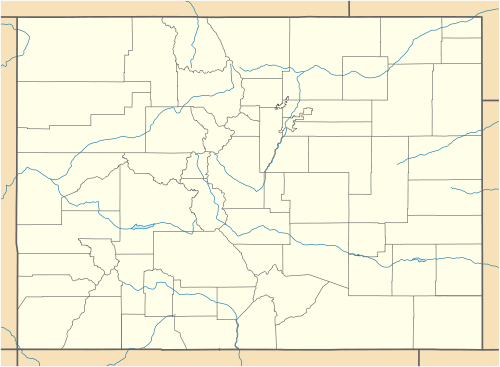Telluride Regional Airport
| Telluride Regional Airport | |||||||||||
|---|---|---|---|---|---|---|---|---|---|---|---|
|
IATA: TEX – ICAO: KTEX – FAA LID: TEX  TEX TEX (Colorado) | |||||||||||
| Summary | |||||||||||
| Airport type | Public | ||||||||||
| Owner | Telluride Regional Airport Authority | ||||||||||
| Serves | Telluride, Colorado | ||||||||||
| Elevation AMSL | 9,070 ft / 2,767 m | ||||||||||
| Coordinates | 37°57′14″N 107°54′31″W / 37.95389°N 107.90861°WCoordinates: 37°57′14″N 107°54′31″W / 37.95389°N 107.90861°W | ||||||||||
| Runways | |||||||||||
| |||||||||||
| Statistics (2007) | |||||||||||
| |||||||||||
Telluride Regional Airport (IATA: TEX, ICAO: KTEX, FAA LID: TEX) is a public airport six miles west of Telluride, in San Miguel County, Colorado. It is owned by the Telluride Regional Airport Authority. At an elevation of 9,078 feet (2767 m) above sea level,[2] it will once again become the highest commercial airport in North America with scheduled passenger flights when Great Lakes Airlines start scheduled passenger service in December 2016.
Facilities and aircraft
Telluride Regional Airport covers 542 acres (219 ha) and has one runway, 9/27, 6,911 by 100 feet (2,106 by 30 m).[2] The runway is on a plateau and still dips slightly in the center, although the dip was more pronounced prior to a renovation in 2009. It can be a challenging but beautiful[3] approach for pilots. In the past during winter months, about 20% of the scheduled commuter airline flights were diverting to other airports because of abruptly adverse landing conditions. This is not unusual since other mountain airports like Sun Valley have similar statistics.[4] When flying to the Telluride Regional Airport, pilots must be aware of unique issues impacting the airfield including high terrain exceeding 14,000 feet (4,300 m), as well as the airport's location on a plateau with a thousand-foot (300 m) drop to the San Miguel River below.[5]
In the year ending April 30, 2007 the airport had 26,709 aircraft operations, average 73 per day: 53% air taxi, 35% general aviation and 12% scheduled commercial. 42 aircraft were then based at this airport: 60% single-engine, 21% multi-engine, 7% jet, 2% helicopter and 10% glider.[2]
Airlines and Destinations
| Airlines | Destinations |
|---|---|
| Great Lakes Airlines | Denver (begins December 17, 2016)[6] |
Historical Airline Service
During the late 1980s, Rocky Mountain Airways operating as Continental Express on behalf of Continental Airlines was flying 50-passenger seat de Havilland Canada DHC-7 Dash 7 turboprops nonstop to Denver (DEN) and Aspen (ASE).[7] The four engine, STOL capable Dash 7 was the largest aircraft ever to provide scheduled passenger service into Telluride. By the 1990s, the airport had ski season nonstop passenger flights to Denver, Phoenix and Los Angeles during the winter months. Mesa Airlines operating Embraer EMB-120 Brasilia and Beechcraft 1900 turboprops flew nonstop to Denver as United Express and to Phoenix (PHX) as US Airways Express. Later US Airways Express services to Phoenix were flown with de Havilland Canada DHC-8 Dash 8 turboprops as the EMB-120s were retired. SkyWest Airlines operating as the Delta Connection flew nonstop Embraer EMB-120 Brasilia service to Los Angeles (LAX). StatesWest Airlines flew Beechcraft 1900C turboprops flew nonstop to Laughlin, NV/Bullhead City, AZ with continuing service to Los Angeles. Great Lakes Airlines flew Beechcraft 1900Ds nonstop to Denver; however, Great Lakes then discontinued all service to Telluride on September 16, 2014.[8] Great Lakes will return to the airport in December 2016 with flights to Denver. The airport has never had scheduled airline jet service although private business jets do operate into the Telluride Regional Airport. Scheduled passenger jet service is available at the Montrose Regional Airport (MTJ) and also at Durango-La Plata County Airport (DRO).
Renovation
Between April 7 and November 4 of 2009 the Telluride runway was closed for a $24 million runway renovation. The west end of the runway was lowered 30 feet, and the east end 14 ft. The material removed was placed in the center, removing the notorious dip in the middle of the runway. In addition, 41 feet of length was added to the runway and retaining walls were built on the side. In 2010, crews widened the airfield's safety areas from 150 feet to 250 feet, installed an Engineered Materials Arrestor System (EMAS) and finished ancillary aspects of the projects. Work on the EMAS was scheduled at night to prevent disrupting operations. These are designed in part to allow larger aircraft to utilize the airport.[9]
Media appearances
Telluride Regional Airport is the destination in the "Telluride Landing" mission supplied with Microsoft Flight Simulator X.
References
- ↑ Telluride Regional Airport
- 1 2 3 4 FAA Airport Master Record for TEX (Form 5010 PDF), effective 2008-06-05
- ↑ https://www.youtube.com/watch?v=ED-mHC85p1o
- ↑ http://www.flysvra.com/pdfs/press-releases/Diversions-Big-Problem-at-FMAA-April-2011.pdf
- ↑ "Unusual Airports: Telluride Regional Airport". Bing. Retrieved August 21, 2010.
- ↑ "Scheduled Denver-Telluride flights return". July 27, 2016. Retrieved September 5, 2016.
- ↑ http://www.departedflights.com, Feb. 1, 1987 Continental Airlines system timetable
- ↑ http://www.telluridenews.com/articles/2014/07/20/news/doc53c9a6664fc67722261780.txt
- ↑ http://www.airnav.com/airport/KTEX
External links
- FAA TEX
- Airport - Live Local Map
- FAA Terminal Procedures for TEX, effective December 8, 2016
- Resources for this airport:
- FAA airport information for TEX
- AirNav airport information for KTEX
- ASN accident history for TEX
- FlightAware airport information and live flight tracker
- NOAA/NWS latest weather observations
- SkyVector aeronautical chart, Terminal Procedures